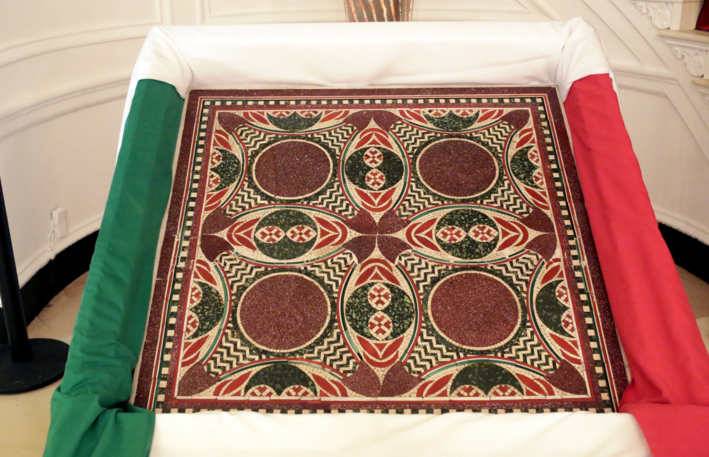


An investigation effectuated by the special art unit of Italy’s Carabinieri police led to the discovery of an ornate mosaic floor tile that was once a part of the roman Emperor Caligula’s [2] ship. In a combined effort with US authorities, this piece of history was rediscovered in New York City at an Italian collector’s apartment. Originally, the mosaic was taken from the naval museum sometime before World War II, but now that it has been retrieved, the Culture Minister Dario Franceschini announced that it will be sent back to the same museum, the Museo delle Navi [3].
Caligula’s Ships
Thousands of years ago, Caligula mandated the construction of three ceremonial ships that were sailed on the volcanic Lake Nemi [4]. These ships, all over 200 feet long, were lavishly designed and adorned in bronze and gold, as well as marble, like the piece found. The magnificent attention to aesthetic detail is noted in the friezes [5] of animals and the extensive use of color. The marble slab itself contains green and red porphyry [6] laid out in an elaborate design. According to some historians, these beautiful ships were used for religious ceremonies.
However, “following the emperor’s assassination, the ship sank and remained underwater for nearly 2,000 years, until it was excavated in the 1920s,” as explained by the Manhattan District Attorney’s office. From 1928 to 1932, fascist leader Benito Mussolini [7] ordered for Lake Nemi to be drained, and they recovered two of the three ships. Anything else found, along with pieces of the ships, were stored in the naval museum for all to see.
Importance of the Mosaic
The Museo delle Navi was used as a bomb shelter in the ‘40s during World War II, and consequently was subjected to an arson attack. Even though the mosaic had been taken prior, many other precious antiquities were destroyed or severely damaged. Accordingly, the mosaic is very rare considering there are not many pieces left of the Emperor’s vessels.
Although historical relics are often lost, they can be recovered as is the case of the roman mosaic. Along with this piece, other artifacts like vases, coins, and various bronze objects were found in the New York City apartment and can now be studied further and learned from.
Source URL: http://test.casaitaliananyu.org/magazine/focus/art-culture/article/us-returns-ancient-roman-mosaic-back-italy
Links
[1] http://test.casaitaliananyu.org/files/mosaic2png
[2] http://www.history.com/topics/ancient-history/caligula
[3] http://www.museonaviromane.it/
[4] https://www.britannica.com/place/Lake-Nemi
[5] https://www.britannica.com/technology/frieze-architecture
[6] http://www.newworldencyclopedia.org/entry/Porphyry_(geology)
[7] http://www.history.com/topics/world-war-ii/benito-mussolini